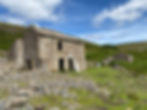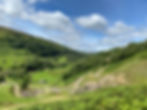The mysteries of Crackpot Hall – the stories behind the name
- timbarber
- Aug 27, 2020
- 4 min read

Just outside the village of Keld on a footpath which connects the village with Muker lies the curiously named Crackpot Hall.
I recently passed it on a walk through the glorious Swaledale countryside in the Yorkshire Dales and was intrigued enough to find out more? So here goes and I hope you like some of my photos.
Crackpot Hall is not some grand mansion as the name suggests but was originally built as a humble farmhouse.

Apparently the name Crackpot is nothing to do with being one sandwich short of a picnic, but the name has part Scandinavian origins from the Viking occupation of the Dale. The Norse word “Pot” means deep hole and there are plenty of caves nearby where the limestone has been eroded by rain and underwater streams flowing through cracks in the rock.
But the word Crack has Olde English origins and translates as Crow. Strangely enough we passed a couple of crows at the entrance to the Biedi lead mine a short distance down the valley towards Muker from Crackpot Hall.

The building is now derelict and has been since the 1950’s when subsidence from the local lead mining caused irrepairable structural damage to the property. But it is recorded that there was a 16th Century hunting lodge known to have stood on the site from when this area of Swaledale was part of a royal hunting forest.
The Crackpot Hall we see today was built on the site of the Hunting Lodge and dates to the early 1700’s when it was originally built as a farm house. But the mainly agricultural dale was transformed in the 1700’s when the Dale turned into a hive of industry as lead mining attracted thousands to Swaledale to make their fortune to mine the lead ore (or Galena) from veins in the limestone.
During this lead mining boom Crackpot Hall became the office for the local lead mine up right up until the late 1800’s. Interestingly, archaeologists more recently have discovered remains of bottles, candles and dynamite wrapped in a newspaper with the date 1983, which had been left behind by the lead miners.

Evidence of the old lead mining industry can be seen nearby at the Beldi Lead Mine smelting mill just to the left of Swinner Gill a narrow side gorge running into Swaledale five minutes walk away. If you look carefully, you can actually see a flue from the smelt mill which ran up the hillside to take away the poisonous fumes.
The Hall changed back into a farm after the miners left and it is this post lead mining time which added to the mystery of the site.

In the 1930’s, two well-known authors (Ella Pontefract and Marie Hartley) who published local history books on the Dales published a story about a four year old girl named Alice who they had discovered roaming wild and barefoot in the area. They claimed her speech and dialect were unintelligible. The story of the ‘wild child” spread and became part of local folklore, persisting in the area for decades.
But in 2015, the BBC investigated the story as part of a radio documentary. The presenter, David Almond managed to clear the matter up and bust the myth after discovering that the residents of the farm at the time were six children who lived there with their parents (one of which was named Alice) – even finding a photo of the family with Alice where she looks distinctly un-feral in the picture!

But the story didn’t end there. Alice was tracked down and found to be living in Carlisle where she was interviewed about her childhood and living in isolation at Crackpot Hall. She did talk about her family’s wild ways and roaming around the farm barefoot with her siblings – where the local valley was her playground.
You can listen to the BBC Radio article on BBC Sounds - https://www.bbc.co.uk/sounds/play/b06nr54x

The crumbling farmhouse has fantastic views up and down Swaledale. As we wandered around we could see evidence of past habitation, including a rusty old tin bath on the floor in front of a fire and an old range where cooking would have been done. Both a small window into past lives.
There is evidence of an old slate roof but it is known at one time to have had a heather or ling thatched roof, from heather collected from the wild moors on the watershed between the Dales.

There are also a number of “shippons” or cow sheds at the one end of the building, so the farm would have had both sheep and cattle.
Crackpot Hall is now part of the Gunnerside estate and they are investing money along with the Yorkshire Dales Millenium Trust on preserving this historic ruined building.

If you are interested about visiting – I have published a separate blog about the walk from Muker to Keld and back which really is one of my favourite walks in the Dales. You can read it on this link:



